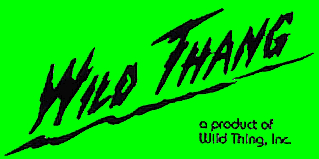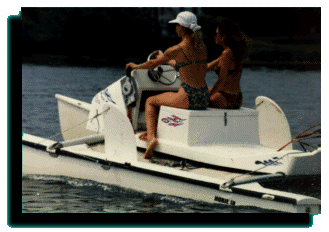
 |
P.O. Box 2060, Key Largo, FL 33037 TEL 305-451-3287 FAX 305-453-0255 E-Mail [email protected] |
Thank you for looking at information about the Wild Thang. The development, testing
and building of this revolutionary new idea/product has been a slow procedure, but we feel we have arrived with
our huge hit at the Miami International Boat Show Last year.
WE MADE IT! Yes, at last, we are here! The first Wild Thang
came off the production line in July, 1994 and has been undergoing sea trials since. We really wanted to find any
problems that could arise.
 I
am happy to report everything is going fine. The unit performs very well
-- acceleration is great, the ride is smooth (even in heavy chop it slices
throught the waves), gasoline consumption is minimal, it operates in very
shallow water, it is extremely roomy and stable, and the ease of launching
surpasses all boats. There is a lot of room on the unit with good storage
under the seat and console, and the decks are clean of cables, hoses and
lines (they are all routed beneath the decking). Owners report that everytime
they use their Wild Thang folks gather around,
asking questions and gawking.
I
am happy to report everything is going fine. The unit performs very well
-- acceleration is great, the ride is smooth (even in heavy chop it slices
throught the waves), gasoline consumption is minimal, it operates in very
shallow water, it is extremely roomy and stable, and the ease of launching
surpasses all boats. There is a lot of room on the unit with good storage
under the seat and console, and the decks are clean of cables, hoses and
lines (they are all routed beneath the decking). Owners report that everytime
they use their Wild Thang folks gather around,
asking questions and gawking.
A Look at the Design's Capabilities
We are very happy with the performance of the Wild Thang. It has turned our little Hobie 18 into an awesome powerboat -- pull water skiers and knee-boarders, go fishing in those shallow bays, go blasting through waves, buzz across the sound to that favorite restaurant on the water, or just take a leisurely spin to watch the sunset.
The Wild Thang is a fiberglass addition that attaches to your present catamaran sailboat (minimal tools required) and comes complete with console and seat. It turns your cat into a safe, stable, quick-turning, smooth-riding powerboat. It can even be launched right off the beach or rolled around on cat-tracks. Try that with any conventional powerboat.
If you decide to go sailing, just snap off the Wild Thang, put up your mast, and it's a sailboat again. With the Wild Thang you can have two boats in one.
 In
testing, we also discovered that the Wild Thang operates quite safely on smaller beach cats,
such as the Hobie 16, 18, Prindle 16, 18, Nacra 5.0, 5.2, 5.5, G-Cat,
and Dart. It does not operate as efficiently on the smaller boats, but
it does appear to be safe and stable.
In
testing, we also discovered that the Wild Thang operates quite safely on smaller beach cats,
such as the Hobie 16, 18, Prindle 16, 18, Nacra 5.0, 5.2, 5.5, G-Cat,
and Dart. It does not operate as efficiently on the smaller boats, but
it does appear to be safe and stable.
On the larger more bouyant cats, like the Hobie 20, 21, G-Force, Mystere 5.5, 6.0, Supercat, Tornado, Prindle 19, Nacra 5.8, 6.0, we have found that much larger engines can be utilized. One buyer is going to place the Wild Thang on a Reynolds 21, and use a 70 HP outboard. He hopes to hit speeds in the 40 to 50 mph range. It appears that the Wild Thang is much more versatile than we originally thought when we designed it.
Due to the light weight of the Wild Thang and cat hulls combined, much less power is required to propel the boat at high speeds. For example, we have been using a Nissan 18 HP and Mercury 15 HP, 20" long-shaft engines and have attained radar speeds up to 25 mph. Those engines weigh under 80 pounds and are extremely powerful. The Wild Thang really performs with either of those configurations on the smaller cats. However, we are now using a 30 HP Johnson and are still getting excellent results and more speed.
Converse to the above, most ordinary powerboats require much more horsepower to make them perform as well as the Wild Thang does with a small engine, and that translates into spending big bucks for the engine alone. For example, a conventional powerboat, even a small Hobie Skiff or Boston Whaler, requires at least 50 HP. Prices for large-sized engines are 2 to 3 times the price of the 9.9 HP engine and fuel consumption is tremendously higher.
- For Wild Thang Pricing Info, Click Here!
- For Other Note about the Wild Thang, Click
Here!

Back to The Welcome Page
